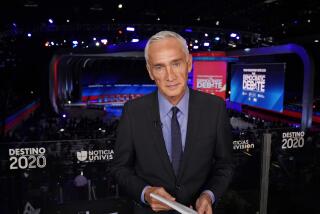What George Lopez can teach Univision
- Share via
WHEN Univision Communications said recently that it was putting itself on the auction block, the announcement was seen as a milestone. With an asking price of $11 billion, a Univision sale would almost certainly rank as the biggest deal in the history of Hispanic media in the U.S. -- a testament, as if one were needed, to the economic clout of the nation’s fastest-growing ethnic group.
But the sale of Univision needs to be viewed as much more than simply a big payday for the company and its iconoclastic chief executive, A. Jerrold Perenchio: It’s also a chance to throw out some flawed and outdated ideas about what Hispanics in this country want when it comes to entertainment.
Most of what they’re now getting, at least on TV, comes from Univision. The company, run by Perenchio, a former Hollywood agent and boxing promoter, is the granddaddy of Spanish-language TV in the U.S. At any given time, its programs are watched by three-quarters of the Spanish-speaking viewers in the country, making it the fifth-largest American network, behind CBS, Fox, ABC and NBC.
That reach has made Univision the no-brainer choice for ad buyers wanting to reach what they see as a single Hispanic market. “It’s a foregone conclusion that Univision is going to receive the bulk of that money,” said Luis Garcia, a marketing consultant in San Antonio.
But those days are ending -- part of a fundamental shift in taste and demographics that not only will make life difficult for Univision’s buyer but will force Wall Street and Madison Avenue to realize that the old way of reaching U.S. Hispanics is tapped out.
For years, Univision profited from immigration. As first-generation Spanish speakers surged into the country, Univision gave them familiar programming, all of it in Spanish and most of it imported directly from Mexico by way of Univision’s partner, Grupo Televisa. The lineup was a mixture of telenovelas, variety shows, Mexican soccer and news.
And that is the way it has remained, even though Univision’s audience has changed radically.
First, the notion of a single Hispanic “market” -- a misconception Univision was happy to capitalize on -- is unraveling. What Puerto Ricans in New York or Cuban Americans in Miami want on television can be very different from what Mexican Americans in El Paso want. Reaching all those audiences -- 41 million people in all -- with a single feed of shows from Mexico no longer works. Advertisers are beginning to recognize the distinctions and, thanks to pinpointed marketing technologies available through the Internet and digital television, can speak to each of these groups separately.
Moreover, the fast-growing audience of young, third-generation Hispanics have different TV tastes from the shows they’re now getting from Univision and Grupo Televisa. These viewers are more affluent and as apt to watch “Desperate Housewives” or “American Idol” as anything on Spanish-language TV.
They also have a different, more nuanced sense of how Latinos should be portrayed in pop culture. Think “Dora the Explorer” on Nickelodeon or “The George Lopez Show” on ABC. Or think, even, of a recent McDonald’s ad featuring a dad and his son bonding over lunch. The fact that both actors in the spot were Latinos was enough to make a subtle point: Yes, we know you’re unique, but no, we don’t have to hit you over the head with it. Although these changes have been underway for years, Univision and its retro-programming have stayed on top for two reasons: the massive reach of the network -- with its more than 60 local TV stations -- and the inertia of clueless advertisers, who couldn’t be bothered to look into an alternative.
Now, finally, ad buyers who specialize in Hispanic marketing say the message seems to be getting through. Philip Remek, a media analyst at Guzman & Co. in Miami, notes that Univision’s ad revenues have begun to slow after years of uninterrupted gains. That’s partly because media buyers in search of younger, more assimilated viewers are going elsewhere to spend their money. “This may not be a short-term blip,” he said.
Marketing money is being diverted to the Internet, to programmers such as MTV that recognize the changing market, and to start-ups such as SiTV, a cable network that is offering up hip, English-language alternatives to the third generation.
All these outlets are after a piece of a spending pie that, according to Hispanic Business magazine, is shrinking as advertisers realize that the notion of a monolithic market peddled by Univision no longer works. Spending on the Spanish-language TV ad market peaked in 2002, according to the magazine, even though household purchasing power now exceeds that of Mexico.
It’s not surprising, then, that Perenchio has picked this moment to try to sell Univision. By unloading the network before all the pressures boil over, Perenchio, who lives in the Bel-Air mansion featured in “The Beverly Hillbillies,” could personally net $1.5 billion. (Not bad for an initial investment of $33 million.)
He’s talked to Viacom about potential deals in the past and is eyeing a proposal from a consortium that includes Haim Saban (the producer behind “Mighty Morphin’ Power Rangers”) and Televisa.
But any deal is going to be complicated, and some analysts, including Remek, are dubious that any agreement is going to materialize. Because of station ownership limits, a merger with an existing broadcaster such as CBS or Fox would force that company to sell off some of its very profitable English-language stations -- an unlikely prospect.
A marriage with Televisa, meantime, would force both sides to bury some bloody hatchets. Univision gets the majority of its programming from Televisa, and Perenchio has long-standing personal and business ties with Televisa’s founding family, the Azcarragas. (In friendlier days, Perenchio threw a wedding party for Televisa’s current chief executive, Emilio Azcarraga Jean.)
But those niceties have since been abandoned. Azcarraga, whose father helped Perenchio buy Univision and whose company still owns 11% of Univision, has morphed from protege to provocateur, loudly criticizing Perenchio for his hands-off management style. Azcarraga has dragged Univision into court in hopes of getting a better price for the programming Televisa provides the company. Any buyer will have to resolve that dispute before moving forward.
To buy the company outright, Azcarraga would have to comply with outdated foreign-ownership laws by pulling a Rupert Murdoch and becoming a U.S. citizen. Although that’s not exactly farfetched -- the magnate is married to a Mexican American and has an American-born son -- it probably wouldn’t sit well at home, where Televisa is by far the biggest media company and where Azcarraga cuts a high profile in business and politics.
Still, among ad buyers and media watchers, there’s a growing sense that any deal for Univision is better than the status quo. The thinking is that the current flow of immigrants, combined with ad buyers still stuck in the old approach to Latino media, can keep the company in the black while a savvier management team retools what’s on the air.
It’s a good idea, but it’s also a lot to ask, with $11 billion and the variety show “Sabado Gigante” on the line.
More to Read
The biggest entertainment stories
Get our big stories about Hollywood, film, television, music, arts, culture and more right in your inbox as soon as they publish.
You may occasionally receive promotional content from the Los Angeles Times.










